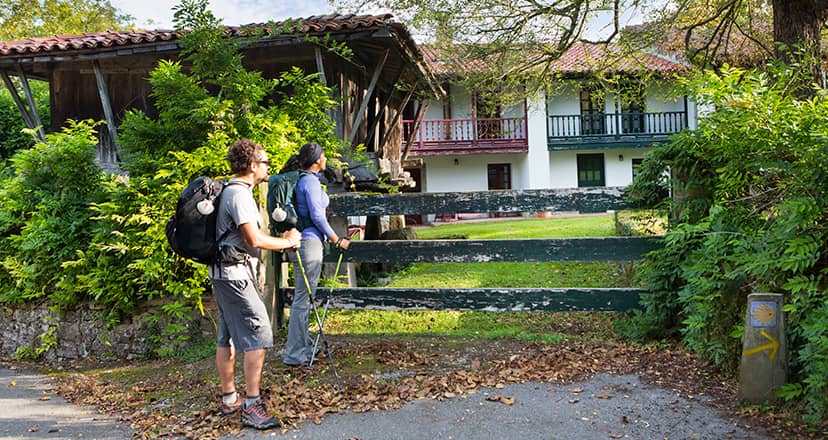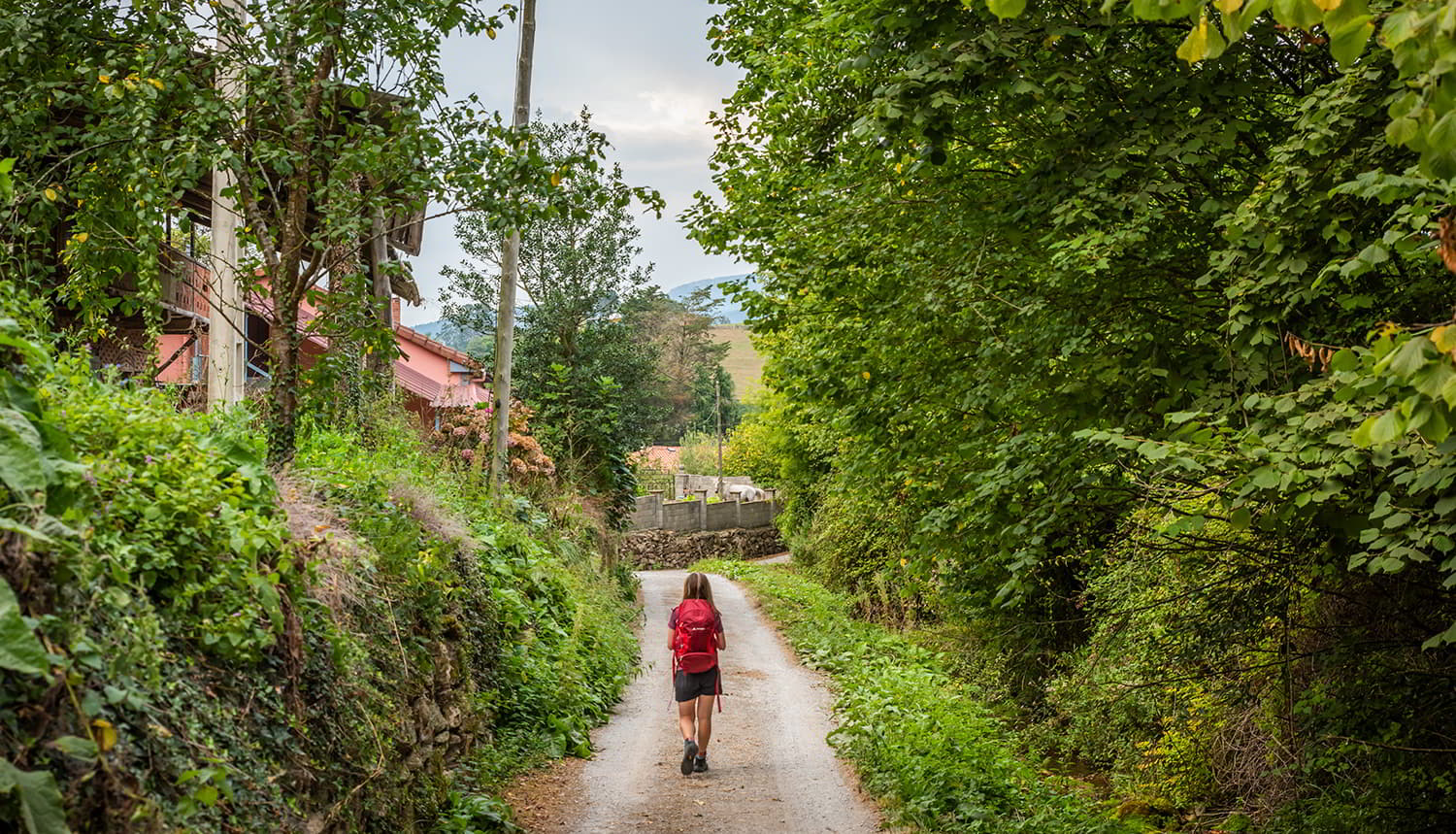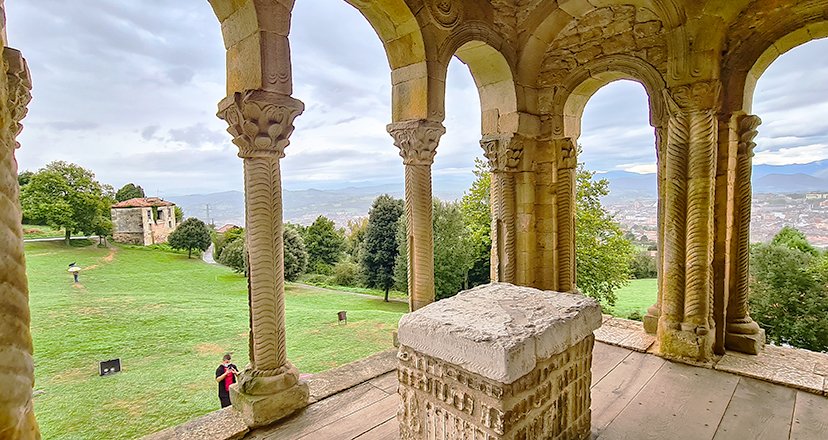Back The essential works of art of the Primitive Way in Asturias

The best works of art on the Primitive Way in Asturias
The Primitive Way of St. James in Asturias has great monumental importance and stands out for the monasteries, palaces and archaeological sites that pilgrims find along the way.
It is often said that the Primitive Way does not have a great wealth of monuments. Although this statement is true - at least if we compare the route that starts in Oviedo/Uviéu with the French Way - it is not entirely fair.
Although the great potential of the itinerary inaugurated by King Alfonso II in what is considered the first pilgrimage to Compostela lies in the landscapes it crosses and in the symbolic fact of following in the footsteps of the pilgrims who unknowingly inaugurated a fundamental milestone in the history and configuration of Europe, we must not lose sight of the fact that its route takes in settings and buildings that were decisive for the future of these northwestern lands.
Once we have left the capital of Asturias, with its cathedral of El Salvador and its pre-Romanesque constructions, echo and summary of a Kingdom whose memory continues to live on through its legacy, the itinerary that enters the south-western areas of the region leaves behind interesting and paradigmatic examples of the weight and importance that these geographical areas came to have, although in some cases their full connection with the central area of the autonomous community has been weakened, but they have not lost their attraction or their charisma.

There are civil or religious constructions that are worth stopping to admire because their stones speak of the vicissitudes of other eras and their lessons serve, to a large extent, to explain our present. There are more, but this is a summary of seven works of art that are essential to understand the importance of the Primitive Way and to get even closer to the history of Asturias.
Palace of the Miranda-Valdecarzana family and Chapel of Los Dolores (Grau/Grado)

The village of Grau/Grado played a very important role in the Middle Ages in Asturias - it was one of the poles founded ex novo by the monarch Alfonso X -, and the original structure of the manor house that belonged to the Miranda-Valdecarzana family dates from that time. However, hardly anything remains of the original construction.
The owners decided to extend it in the 17th century and the palace underwent a new refurbishment in the 18th century, when between 1713 and 1716 the Chapel of Sorrows was built behind it. Conceived as an oratory for the exclusive use of the family, its plans are attributed either to Francisco de la Riva Ladrón de Guevara or to his uncle, Francisco Alonso de la Riva, who was also an architect.
The interior of the chapel is exuberantly decorated, making it one of the most renowned pieces of Asturian Baroque art. Today, both buildings fulfil a public function, far removed from their original purpose. The chapel does not house worship services and is used as a stage for musical performances, stage shows and various social events.

The palace houses the municipal plenary hall and the council's public library. It also houses the headquarters of the Aula de las Metáforas, created by the poet Fernando Beltrán.
Monastery of San Salvador de Cornellana (Salas)
Its unexpected presence in the middle of the Way is so imposing that it almost seems like a mirage. The Monastery of San Salvador de Cornellana stands on a bend in this town, at the foot of the point where the Nonaya flows into the Narcea and very close to the spot where Ramiro I confronted Nepociano, when both were competing for the throne left vacant by Alfonso II. You only have to look at the grandeur of the building to realise how important it was in medieval Asturias.
The Infanta Cristina, daughter of King Bermudo II and Queen Velasquita, founded it in 1024 and retired to pray inside it. There is a legend about it: it is said that she chose this place to erect the convent because she herself, as a child, had got lost in the woods that populated these parts and was rescued by a bear that adopted her as if she were one of its litter and took care of her until her frightened parents found her. The official story is more prosaic, but no less interesting. The monastery joined the Cluny congregation in 1122, which led to a major reformation that culminated in the 13th century with a remodelling of its church. Subsequently, it was involved in the noble conflicts that played a leading role in the last stages of the Asturian Middle Ages.
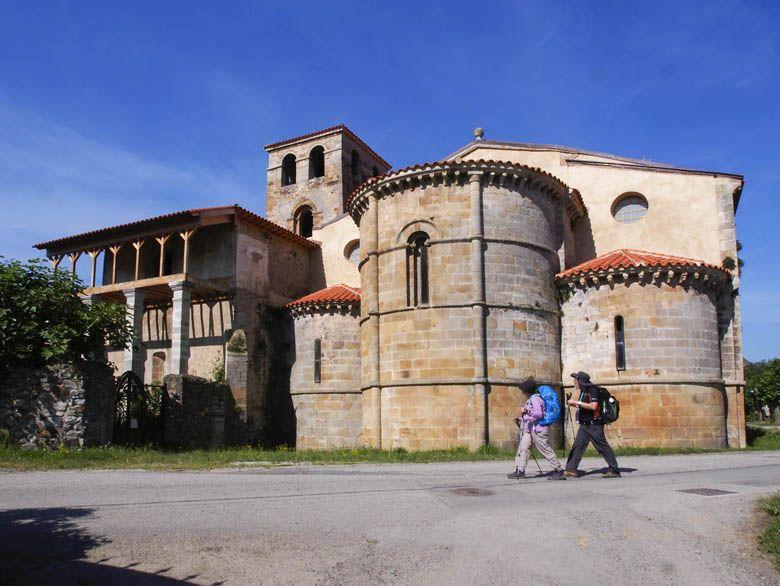
In the 17th century it became part of the Benedictine congregation of Valladolid - which explains the presence of the coat of arms of Castile and León on the façade of the church - and later the cloister was rebuilt, which was configured as it is today. After the French invasion, the building was used to keep horses and then burnt down.
After so much hustle and bustle, it once again became part of the Bishopric of Oviedo in 1878. It is worth stopping at its Romanesque church, with special attention to the beautiful apse that bids farewell to the pilgrims as they set off on their ascent to Sobrerriba. There is a hostel there, and the more curious can indulge in the pastime of searching among its reliefs for the one that shows the famous bear suckling the infant Infanta Cristina.
Collegiate Church of Santa María la Mayor (Salas)

The Collegiate Church of Santa María la Mayor de Salas is one of the finest examples of Asturian Gothic architecture, of which examples are rather rare, and also the main symbol of the power of the family that sponsored its construction. The Valdés-Salas family founded it in the first half of the 16th century, although later side chapels were added to the original plan, and today, in addition to the elegant simplicity of its elevation, two altarpieces can be admired here: the main altarpiece, attributed to the Valladolid school and dating from the 17th century, and that of the Malleza family, erected in the same century and signed by the architect Pedro Sánchez de Agrela and the sculptor Luis Fernández de la Vega.
Its greatest attraction, however, lies in the pantheon that was sculpted on the northern side of the apse and where Fernando de Valdés-Salas, the most famous member of the lineage, rests. He was the founder of the University of Oviedo/Uviéu, but he was also inquisitor general and president of the Royal Council of Castile. His funerary monument was sculpted in alabaster by Pompeyo Leoni, an Italian artist who worked for Felipe II in El Escorial, and if you visit the collegiate church in the afternoon and the last of the sun manages to filter through the windows of the temple, its contemplation can turn from hypnotic to overwhelming.
Monastery of Santa María la Real de Obona (Tineo)
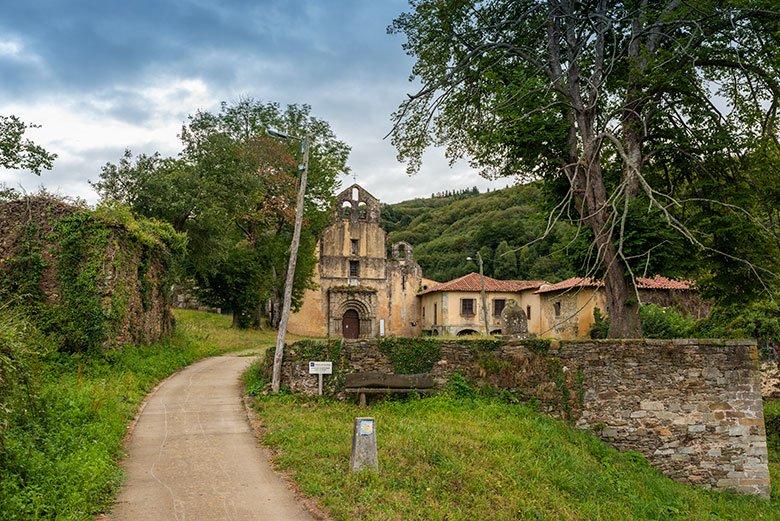
Few buildings are so paradigmatic, not only in terms of the historical and artistic heritage of Asturias, but also in terms of the sentimental imagery of the southwest of the region. The importance of the Monastery of Santa María la Real de Obona was so great that King Alfonso IX ruled that pilgrims on their way to Santiago following the original Asturian route were obliged to visit it. It is a singular mandate if you consider that the monastery is not strictly speaking on the Primitive Way, but that to reach it you have to walk some four hundred metres off the route.
It should be noted that the effort is rewarded. The monastery of Obona is a place as beautiful as it is strange and, in fact, its very origins are shrouded in legend. Traditionally, its foundation is attributed to a prince Adelgaster, supposedly the bastard son of King Silo, and his wife Brunhild. Although the existence of neither of them has been verified, their tombstone is preserved in the apse of the church. Its construction began in the 13th century and its Romanesque construction scrupulously respects the parameters imposed by the Cistercian order.

The monastery soon acquired great power in the economic and cultural spheres. Theology, Latin and philosophy were taught there. Agricultural and livestock farming techniques were also modernised from its domains. This is where the first written reference to cider, the quintessential Asturian drink, comes from. There was a dark side: it seems that the monks often exceeded their powers and were not very well liked by the locals. The cloister and the monastic quarters began to be reformed in the 18th century, but the crisis in the monastery prevented the remodelling from being completed. Santa María la Real de Obona was abandoned with the disentailment and a sad story of grievances and damage began. There were neighbours who took stones from the building to renovate their houses, and priests who did not hesitate to sell anything of value that might be left there. Fortunately, not everything was lost.
The superb Romanesque church is already a value in itself, and from its triumphal arch hangs a Christ that many consider to be the most perfect religious sculpture of all medieval Asturian art. Finding the keys and gaining access to the interior may involve the pilgrim wandering around the village more than he initially thought, but he will be fully redeemed when, on opening the doors, all the beauty and mystery of a monastery unfolds before his eyes which, despite successive decadences, conserves its main charms.
Palace of the Cienfuegos de Peñalba (Allande)
On the top of a hill that overlooks the ups and downs of the secluded village of Pola de Allande (or La Puela, as it is known), the palace of the Cienfuegos family, lords of Allande and counts of Marcel de Peñalba, is one of the most magnificent sights that pilgrims can witness on their way to Santiago de Compostela. Its original construction dates from the 14th century, although it was rebuilt around 1520 by Rodrigo González de Cienfuegos and underwent a new remodelling in the 18th century to adapt it to the needs of the time. Its original defensive vocation is evident in the sobriety that characterises its façade and in the three towers without battlements that emphasise its intruder-proof fortification. Only the lower part of the building remains from the Gothic period, and some Renaissance decorative elements can still be seen in the rear courtyard.

The building is privately owned and cannot be visited, although the greatest impression is made by its silhouette emerging from the landscape, like a forgotten reminiscence of the old lordships that imposed their dominion and control over these lands.
Chao Samartín (Grandas de Salime)
It is located on the outskirts of the small village of Castro, about five kilometres from the town of Grandas de Salime, where the Primitive Way enters its last kilometres in Asturias and heads towards Galicia. The Chao Samartín is one of the most important archaeological sites in the entire autonomous community, as it highlights the great importance of these lands, today somewhat remote from the major centres of territorial decision making, during a long and crucial period in our history. It was founded in the late Bronze Age, around the 9th and 8th centuries BC, and remained inhabited until the end of the 2nd century, in the midst of Roman domination.
It was abandoned when a strong seismic movement destroyed its constructions and confined them under the earth. It seems that a necropolis was located over its ruins in the times of the Asturian Monarchy, which meant that the site was used for funerary purposes throughout the Middle Ages.
Then came abandonment, decadence and oblivion. Although the geographical dictionaries of the 18th and 19th centuries mentioned the existence of fortifications in the area, it was not until 1967 that it was recognised that there must indeed have been something under those lands. It was the ubiquitous José Naveiras, founder of the Ethnographic Museum of Grandas de Salime, and known throughout the region as Pepe El Ferreiro, who first came across the remains of an ancient hut.

The official excavations began in 1990, with the archaeologists Elías Carrocera and Ángel Villa in charge of the work. The results, although flattering from the outset, could hardly have foreshadowed the discoveries that were to be made in the 21st century. Unexpectedly, the remains of a Roman domus were discovered there, which is the best example of the high regard in which these domains full of golden veins were held in the Empire.
The house of the Lord of Grandas - as its anonymous and, given appearances, very powerful inhabitant is known - is today the jewel in the crown of the Chao Samartín, without detracting in any way from the pre-Roman part of the settlement. A few metres from the castro is a small archaeological museum that houses pieces from the castro and other settlements from that period that are preserved in the Navia-Eo region. These are the last vestiges of an Asturias that is as remote and hidden as it is essential.

Subscribe to our newsletter and take advantage of offers, discounts, and news
Subscribe

